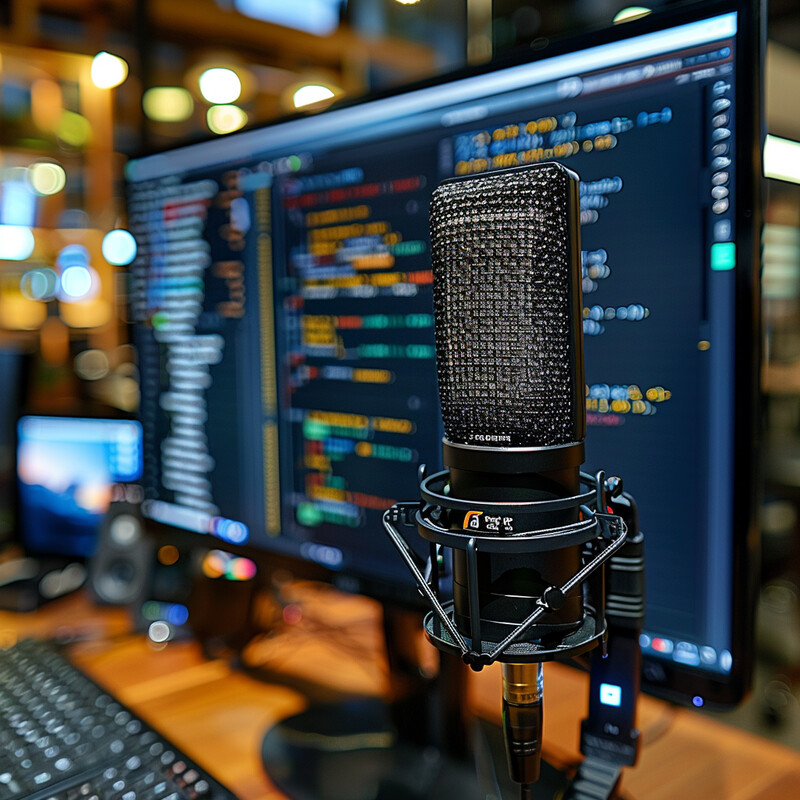1. Content Personalization
AI is transforming how radio and podcast listeners discover content by powering personalized recommendations. Modern streaming platforms and podcast apps use algorithms to analyze listener behavior — such as play history, likes, and skips — to curate feeds tailored to individual tastes. This means that each user can receive a custom lineup of podcasts or radio segments that align with their interests, increasing engagement. For creators and broadcasters, personalization drives longer listening times and loyalty, as audiences are more likely to find content they enjoy. Furthermore, AI’s ability to process massive libraries of audio content in real-time helps surface niche or new shows to the right listeners, addressing the “discovery problem” in the crowded podcast space. Overall, content personalization through AI leads to a more user-centric listening experience, benefiting both audiences and content providers.

Major audio platforms have heavily invested in AI for personalized content recommendations. For example, in late 2023, Spotify announced it is leveraging Google Cloud’s AI (including large language models) to better understand users’ listening patterns and provide tailor-made podcast and audiobook suggestions. Spotify — which hosts roughly 5 million podcast titles — had earlier pioneered AI-driven music recommendations and is now applying similar techniques to spoken-word content. Company executives noted that these tools help identify what a user might want to hear next, out of an enormous content library, by augmenting metadata and analyzing listening behavior. This use of AI for personalization underscores a broader industry trend: streaming services are increasingly using advanced algorithms to improve content discovery and keep listeners engaged with recommendations uniquely tuned to their preferences.
2. Speech-to-Text Transcription
AI-powered speech-to-text transcription has become an essential tool in radio and podcast production, dramatically improving efficiency and accessibility. Modern transcription algorithms can automatically convert spoken audio into accurate text in real time or post-production. This capability allows producers to generate full transcripts of shows with minimal manual effort, which can be used for editing, search indexing, and content repurposing. Crucially, transcriptions make audio content accessible to deaf or hard-of-hearing audiences and enable all listeners to follow along in noisy environments or when audio can’t be played aloud. They also enhance discoverability: text transcripts mean that search engines can index the content of podcasts, allowing potential new listeners to find episodes by keywords. In summary, AI transcription has made it feasible for even small podcast teams to offer written versions of their audio content, broadening audience reach and improving the user experience.

Recent advances in AI transcription are evident in industry initiatives. In 2024, Apple rolled out an auto-transcription feature for all new podcasts on its platform, reflecting how mainstream this technology has become. This came in response to rising demand for accessibility: weekly podcast listenership in the U.S. has quadrupled in the past decade, and about 15% of U.S. adults (roughly 37.5 million people) report serious hearing difficulties, many relying on transcripts or captions to consume media. Prior to this, lack of transcripts was even the basis of lawsuits (e.g. against SiriusXM and others) for violating accessibility standards. Now, AI-driven transcription services achieve high accuracy and are fast enough to be deployed at scale by major platforms. By automatically generating transcripts, companies like Apple and Spotify have improved content searchability and inclusivity, ensuring that podcasts and radio shows can be read as well as heard.
3. Audio Quality Enhancement
AI plays a pivotal role in elevating the audio quality of radio and podcast recordings. Advanced audio processing algorithms can automatically detect and reduce background noise (like hum, hiss, or room echo), making voices sound clearer and more professional. They also normalize volume levels and equalize sound frequencies on the fly, which means the listener doesn’t need to adjust the volume between loud and quiet segments. Some AI tools can even repair audio issues by analyzing the signal – for instance, removing a sudden pop or balancing stereo channels – which previously required skilled sound engineers. By ensuring consistent clarity and loudness, AI audio enhancement improves the listening experience across various environments (from car speakers to earbuds). For producers, these intelligent tools save time in post-production: tasks like noise reduction and leveling can be handled or at least guided by AI, allowing creators to focus on content. Overall, AI-driven enhancement helps even small or remote productions achieve studio-like sound quality reliably.

The capabilities of AI in audio enhancement are well documented in industry research. For example, an article in the ACM eLearn Magazine (2023) highlighted that AI-powered audio editing tools can “automatically clean up background noise, remove echo, and enhance overall sound quality…ensuring a professional and immersive listening experience for the audience.” These tools use machine learning algorithms trained on vast amounts of audio to distinguish unwanted noise from speech. Companies like Adobe and Descript have introduced one-click AI filters (such as Adobe’s “Enhance Speech” feature) that make a recording sound as if it were captured in a soundproof studio. The impact is significant: podcasters without audio engineering expertise can vastly improve recording clarity with minimal effort. As noted by Austin and Samuel (2023), such AI-driven audio optimization not only saves editing time but also maintains listener satisfaction by delivering clear and balanced sound consistently.
4. Automated Editing
AI is streamlining the podcast and radio editing process by automating many of the tedious tasks that used to require hours of manual work. Editing software enhanced with AI can automatically remove long pauses, filler words (like “um” and “uh”), and false starts from recordings, producing tighter and more polished audio. Some systems can even identify off-topic digressions or errors (for instance, a mispronounced name retaken by the host) and suggest cuts. Beyond cutting, AI can assist in assembling segments: for example, it can match and align audio clips from different takes, helping create a seamless final version. This level of automation accelerates post-production — what might have taken a human editor an afternoon might be done in minutes by AI, with a human just fine-tuning afterward. For independent creators, automated editing lowers the skill barrier, enabling them to achieve professional-sounding results without hiring an engineer. In essence, AI is like an intelligent assistant editor, handling the grunt work and allowing human producers to concentrate on creative decisions.

Top podcast producers have quickly embraced AI editing tools, and these are now common in major studios. A report in Wired noted that AI-based editing software is “frequently used by major podcasting studios” to simplify routine tasks. These tools can automatically strip out background noises or mumbled words and can even help with content tasks like leveling speaker volumes. One high-profile example is the software Descript, which uses AI to let editors cut audio by editing text (like a document) — delete the text of a stutter or filler word, and the audio is cut accordingly. This kind of innovation has made editing more accessible and significantly faster. As Wired highlighted, such AI-driven editors have become part of the standard toolkit: producers at well-known studios use them to maintain efficiency and consistency. The adoption of AI for editing underscores the industry’s effort to reduce production time while maintaining (or improving) audio quality.
5. Advertisement Insertion
AI is optimizing how and where advertisements are inserted into audio content, in order to maximize both listener experience and ad effectiveness. In traditional podcasting, ads were often either baked in by the host or placed at standard breakpoints. Now, AI-driven analysis can determine the ideal moments for ad breaks by examining listener engagement data — for example, ensuring an ad doesn’t interrupt a climactic moment in a story, or choosing a point where a slight drop in attention typically occurs. AI can also personalize ad insertion in dynamic ad delivery: different listeners might hear different ads or a different number of ads, selected by algorithms based on user data (location, interests, listening history) while respecting privacy. This targeting helps make ads more relevant, which can improve listener tolerance and advertiser outcomes. Additionally, AI can automatically adjust the audio levels and transitions for inserted ads, so they sound smooth and not jarring compared to the content. In sum, AI is making the ad placement process smarter — balancing the needs of monetization with the goal of keeping audiences listening.

Data-driven ad insertion has become increasingly prevalent in the podcast industry. A 2023 market study by the Interactive Advertising Bureau (IAB) revealed that while most podcast ads are still placed in specific shows, about 25% of podcast ad inventory was bought using audience targeting rather than show-specific placement. This indicates a growing reliance on algorithms to decide where ads should go and who should hear them. Platforms like Spotify and iHeartMedia use AI-based targeting to deliver ads at times when listeners are most likely to be engaged and to select ads that match listener profiles. The result has been a significant boost in advertising efficiency — for instance, targeted (audience-based) buys have been growing year-over-year as advertisers see better conversion rates. The IAB report underscores that publishers are leveraging AI to increase revenue “without disrupting the listener experience,” showing that ad tech is now an integral part of audio platforms.
6. Voice Synthesis
AI-driven voice synthesis is opening up new possibilities in radio and podcast production by creating realistic artificial voices. This technology can clone a real person’s voice or generate a entirely new synthetic voice that reads scripts in a lifelike manner. For producers, voice synthesis means that they can generate narration or even full hosts without the person being physically present or, in some cases, without a human actor at all. It offers a cost-effective way to produce segments like news reading, weather updates, or voiceovers, since an AI voice can work 24/7 and instantly “speak” any text fed into it. Creative opportunities are also emerging: podcasts can feature cameo “performances” by an AI-generated voice imitating a historical figure or fictional character. In radio, some stations have experimented with AI DJs that emulate the style of human hosts. While the technology raises ethical and quality considerations (audiences can be sensitive to unnatural tones), it is rapidly improving. In practice, AI voices today can inflect emotion, adjust pacing, and even mimic the nuances of specific individuals. This means voice synthesis is becoming a practical tool to augment human talent, expand multilingual content (via dubbing), and ensure continuity (an AI voice can fill in if a host is unavailable).

A remarkable real-world example of AI voice synthesis in action is “AI Ashley,” introduced in mid-2023 at a radio station in Portland, Oregon. Using a system called RadioGPT, the station cloned the voice of its human midday host, Ashley Elzinga, to create an AI DJ that broadcasts for several hours a day in her voice. The AI DJ is fed scripts generated by GPT-4 (a language model), and then it reads them on-air using the synthetic clone voice, producing content that sounds like the real host speaking live. This was one of the first instances of a major station putting an AI-generated voice on the air in a regular timeslot. Importantly, the station has been transparent about it being an AI persona. The move demonstrated the maturity of voice synthesis: listeners heard familiar voice inflections and tone, even though the real host wasn’t speaking. Radio conglomerates have noted that such AI voices, once perfected, could handle routine announcing tasks, and indeed the largest U.S. radio network (iHeartMedia) cited investments in AI voices and automation as a reason for a company-wide restructuring. In 2020, iHeartMedia started using AI software to schedule music and even to mix songs with voiceovers, heralding a new era where parts of a broadcast can be automated without a live DJ present.
7. Music Recommendation and Mixing
AI is increasingly used to handle music selection and mixing duties, both in streaming services and within podcast/radio production. In the context of radio programming, AI-driven systems (often called music schedulers) can analyze listener preferences, song characteristics, and even contextual factors (time of day, trending genres) to pick the next track in a way that keeps the audience engaged. This goes beyond simple rotation rules — modern AI can learn what sequences of songs retain listeners or cause tune-outs, adjusting playlists dynamically. In podcast production, AI can assist with background music decisions, automatically suggesting music beds or transition stingers that fit the mood of a segment. For instance, if a podcast segment has a suspenseful tone, an AI tool might recommend a low, tense instrumental piece from a stock library. AI can also handle the technical side of mixing, such as ducking background music volume when dialogue is detected, to ensure speech remains clear. All of this leads to a more polished final product with less manual trial-and-error. Moreover, generative AI models can compose original music on the fly, giving creators easy access to bespoke soundtracks without licensing worries. In summary, whether it’s a radio DJ set or a narrative podcast’s score, AI is helping choose and blend music in a way that enhances storytelling and listener enjoyment.

The radio industry offers a telling case of AI’s impact on music programming. In January 2020, iHeartMedia (which operates over 850 radio stations) announced it had developed AI “centers of excellence” and was using advanced software to take over tasks like music scheduling and song mixing. According to a report by The Washington Post, iHeart’s system uses algorithms to analyze audience research and choose songs, as well as to seamlessly mix tracks, which were roles traditionally handled by human DJs and producers. The company positioned this AI pivot as essential for staying competitive in an era of streaming — by leveraging automation, they could provide a highly optimized music lineup for each station and even personalize some content for digital listeners. This strategy resulted in job cuts of some on-air staff, underscoring how effective the AI had become at core programming tasks. By 2023, other broadcasters and streaming platforms had similarly invested in AI for music curation; Spotify, for example, launched an AI DJ feature that personalizes music mixes for individual users using an AI voice and recommendation engine. All these developments illustrate that AI’s role in music selection and mixing is no longer experimental but central to modern audio content delivery.
8. Predictive Analytics for Trending Topics
AI is helping content creators stay ahead of the curve by predicting which topics or stories are likely to trend with audiences. Using predictive analytics, algorithms sift through enormous amounts of data from social media, search queries, and online news to identify emerging patterns and hot topics in real time. For a radio show or podcast, this means producers can get data-driven clues about which subjects listeners might find interesting in the near future (for example, an uptick in online chatter about a new technology or a developing news story). By aligning content planning with these insights, creators can produce episodes that are timely and relevant, potentially catching audience interest just as it peaks. This reduces the guesswork in topic selection and can improve show performance (more downloads or listeners) because the content resonates with what’s on people’s minds. Additionally, AI can localize trend predictions, telling a regional radio station what’s trending in their city vs. nationally. Predictive analytics tools often present these findings in dashboards, highlighting keywords or sentiment trends, so producers and hosts can decide how to angle their discussions. Essentially, AI acts as a research assistant that never sleeps — continuously monitoring the zeitgeist and informing content teams so they can be proactive rather than reactive in their programming decisions.

The use of AI for identifying trending topics has become prevalent across news and media organizations in recent years. A global survey by the Reuters Institute in 2023 found that a significant number of publishers were experimenting with AI to support newsgathering and content planning, with an eye on trend prediction. In fact, by 2025, about 73% of news publishers expected to be using AI tools for tasks like monitoring social media trends and spotting emergent topics of interest (Newman, 2025). This reflects a sharp increase in adoption compared to just a few years prior. One concrete example is The Associated Press, which has an AI-driven system to alert journalists to breaking trends on Twitter and Reddit before they become obvious. Similarly, many podcast networks use social listening AI to decide what pop culture or political topics to cover each week, based on early signals of audience interest. The momentum is such that media teams now consider these AI trend forecasts as crucial input — often alongside editorial judgment — when setting the lineup for an upcoming show or series. The data shows that episodes aligned with rising trends can see a bump in engagement, validating the predictive approach.
9. Listener Engagement Analysis
AI is enabling deeper analysis of listener engagement, giving podcast and radio creators actionable insights into how audiences interact with their content. Instead of relying solely on download counts or traditional ratings, producers can now examine granular metrics: where in an episode listeners tend to drop off, which segments they replay, what speed they listen at, etc. Machine learning algorithms can sift through these data points across thousands of listeners to find patterns — for instance, identifying that a particular interview in a podcast consistently holds attention until the end, or that episodes longer than a certain length see a steep fall-off. These insights help creators refine their format and content. If the data shows many people skip a long intro, the host might shorten it in future episodes. If a certain topic led to higher completion rates, the team might plan more content around that topic. AI also helps in A/B testing: some platforms allow releasing two versions of an episode intro to subsets of the audience, and AI analyzes which performs better in terms of keeping listeners. For radio, which traditionally had less direct feedback, digital streaming data analyzed by AI can show which segments cause channel switching. In summary, AI-driven engagement analytics takes the guesswork out of understanding audience behavior, allowing content creators to continuously improve and tailor their shows to what listeners actually prefer.

Leading podcast platforms have rolled out advanced analytics dashboards powered by AI to parse listener behavior. In 2023, Spotify introduced a suite of new podcaster tools, including an Audience Network Performance Dashboard, which uses data analytics to help creators see how listeners discover and engage with their podcast. These analytics go beyond simple plays: creators can now see metrics like the impression-to-listen conversion rate (how many people seeing a podcast listing actually click play) and the average listen-through rate for episodes. According to Spotify, providing these detailed insights has allowed producers to increase their listener retention. For example, one podcaster noticed a recurring drop in listeners about 75% through each episode — by checking topic timelines, they realized the dip often coincided with off-topic banter, which they then trimmed in subsequent episodes, improving completion rates. Similarly, Apple Podcasts’ analytics (updated through 2023) show the percentage of the episode listened to on average, and many creators have used that to optimize episode length (Perez, 2023). Industry-wide, such AI-powered engagement analysis has become standard: a survey in late 2023 found that a majority of professional podcasters routinely consult analytics before making content decisions. This data-driven approach marks a significant shift in content strategy, driven by what the numbers reveal about audience habits.
10. Language Translation and Dubbing
AI is breaking down language barriers in audio content by enabling real-time translation and dubbing of podcasts and radio programs. With AI translation, a show produced in one language can be automatically rendered into another language, often almost immediately after the original release. Beyond plain text translation, modern systems can generate spoken audio in the target language — this is “AI dubbing,” where a synthetic voice (sometimes even mimicking the original host’s voice) delivers the content in another language. For content creators, this technology dramatically expands potential audience reach, allowing them to serve listeners in multiple linguistic markets without recording separate versions from scratch. It also preserves the personal feel of a podcast: rather than a third-party narrator interpreting the show, the AI can make it sound as if the host is fluent in many languages. International radio services have started to use AI to quickly offer news bulletins in various languages using a single workflow. Additionally, for archival content, AI can retroactively translate old episodes, giving them new life with new audiences. The result is a more globally accessible audio landscape — popular podcasts can develop followings in other countries, and important information (like emergency broadcasts or educational programs) can be disseminated widely, crossing language divides with the help of AI.

A notable development in 2023 was Spotify’s launch of an AI voice translation pilot for podcasts, in partnership with OpenAI. In this pilot program, Spotify used AI to translate several popular English-language podcast episodes into Spanish (with French and German versions planned), all while preserving the original host’s voice. This means listeners hearing the Spanish version experience the show as if the host is speaking Spanish, complete with the same tone and vocal characteristics, thanks to voice cloning technology. The translated episodes included those from well-known hosts like Dax Shepard and Lex Fridman. According to Spotify’s announcement, this AI system can generate these foreign-language episodes much faster and more cheaply than manual human dubbing. Early user feedback noted the novelty of hearing familiar voices in a different language, and it suggested strong potential for reaching non-English-speaking audiences. Other companies are following suit: startups are offering AI dubbing services for podcasters and radio producers, and YouTube has been testing AI-generated multilingual audio tracks for creators as well. The success of Spotify’s pilot, where listeners could seamlessly enjoy content in their native language, points toward a future where language translation becomes a standard optional feature for major podcasts.